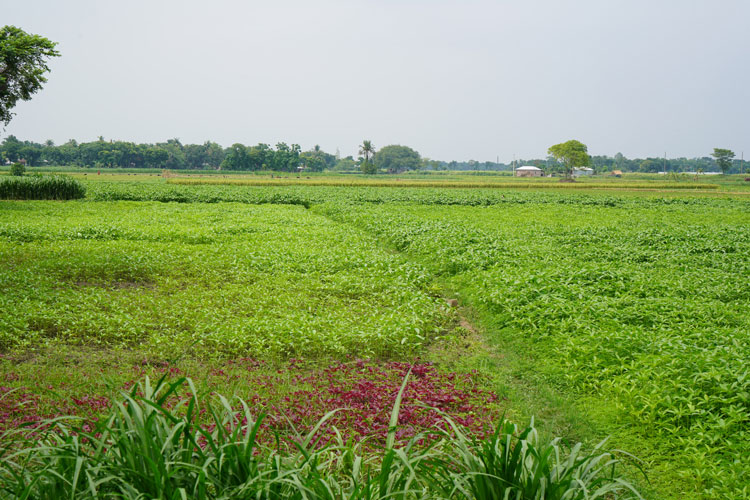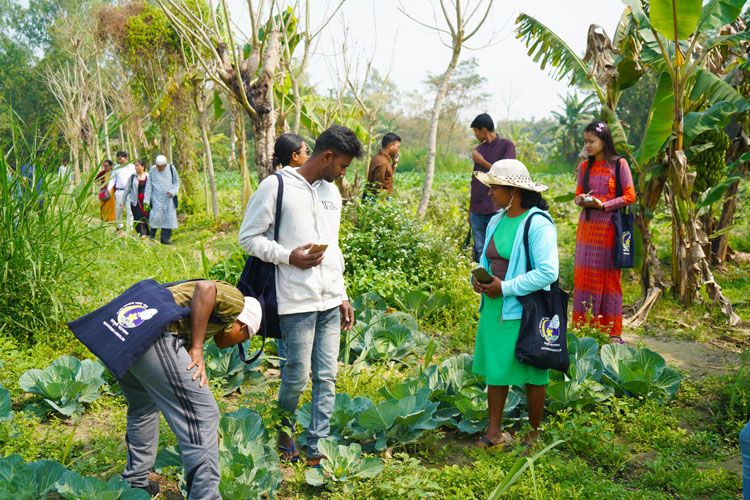Join with Nayakrishi sdf
 Nayakrishi Andolon || Tuesday 15 October 2024 ||
Nayakrishi Andolon || Tuesday 15 October 2024 ||
Discussion meeting for organizing Nayakrishi (Biodiversity based ecological agriculture) learning session was held involving 20 farmers at Habashpur village, Nandalalpur Union, Kumarkhali Upazila, Kushtia district. There were six farmers aged between 40-45 years. 12 were youths, two were disabled families and two farmers were share croppers.
In addition, there were two old Nayakrishi farmers those who were practicing Nayakrishi since introduction and were encouraging other farmers practicing Nayakrishi.
About the village:
The village is situated on the bank of the river Gorai, a branch of the great river Padma. The south-west side of the village is encircled by the river Gorai. Consequently, one third of the village is touched by the river. There was a time when farming and fishing were the main profession of the people. The village was enriched with varieties of crops. The land of the village was fertile with annual siltation for the river in the rainy season. The farmers used to grow varieties of crops with plowing and sometimes without plowing. They used to grow Kalabakri, Vorilota, and Hidi varieties of aus rice. The farmers used to irrigate land with an indigenous equipment called ‘don’. They used to grow groundnut, pulses, millets and barley. Farming was their main profession and fishing was their lovely hobby. However, some landless families used fishing as their main source of livelihood. Cows, goats, ducks and chickens were there in almost every houses. The life of the people was tuned with the land and the river. The people were self-contained in terms of food and other essential items.

Total number of households:
There are about 200 households in the village. About 80% are farmers and others have small business. There are 6-7 poor households who are the landless farmers.
Type of farmers:
About 25% are owner farmers, farming on their own land. They have three bigha of land (99 decimal) each. About 60% of farmers have land up to 50 decimals. They also practice share cropping. The remaining 15% have 10-20 decimals land each, they also take lease of land and share crop. Lower middle-class farmers are majority in the village.
Two third of total land is sandy loam.
Present Cultivation Method:
Encouraged by the companies the farmers were misguided to adapt chemical based so called modern agriculture. The major impacts are clearly visible in terms of loss of landraces of crops that were indigenous to the locality, the loss of soil nutrients making it unproductive and excessive use of pesticides destroying biodiversity and increases the presence of its residues in food and environment. The farmers were caught in the vicious trap of chemical agriculture.
The farmers are now trying to get out of the poisonous cycle. They are now using cow dung and compost for improving soil.
Crop variability
The farmers are now growing varieties of crops including rice, wheat, maize, pulses, and vegetables.
Rice – The main rice varieties are guti sharna, babu sharna, kalijira, badshavog, BRRI dhan 11, 29, and 79
Pulses – Lentil, pea, black gram
Oilseed – Mustard, sesame
Spices– Coriander, onion, garlic, chili
Vegetables– Cabbage, cauliflower, brinjal, shim, okra, tomato, cucumber, better gourd, sponge gourd etc.
Others – Sugarcane, banana
Variability of livestock and poultry including local breed of cow, goat, duck, chicken, pigeon, etc.

Farmers’ realization
The farmers now realized that the use of so-called modern technology like the use of chemical fertilizers depleted the soil natural fertility and pesticides generate resistant pests. The farmers need more fertilizer and pesticides to achieve the same results. Environmental degradation makes modern agriculture overall inefficient. The cost of production is higher than return from production. Some of them visiting the Nayakrishi farmers besides their neighboring villages. They are now planning to go to biodiversity based ecological agriculture in consultation with Nayakrishi farmers.
